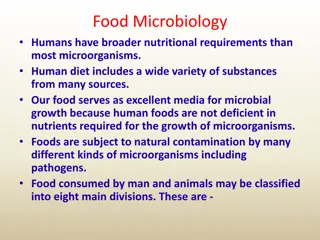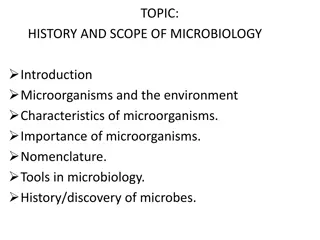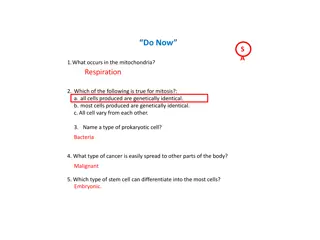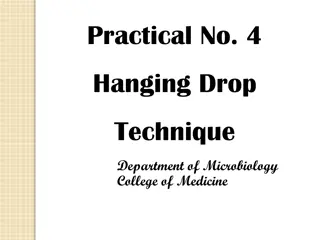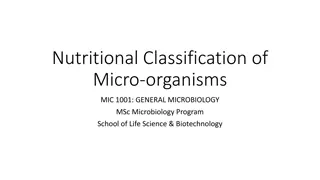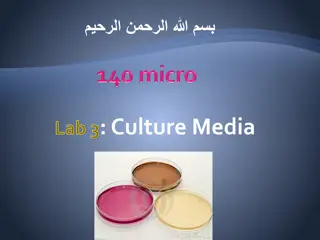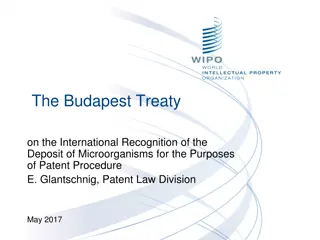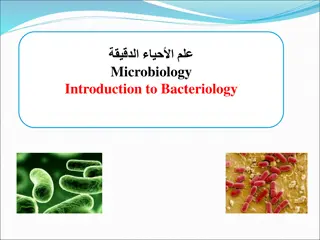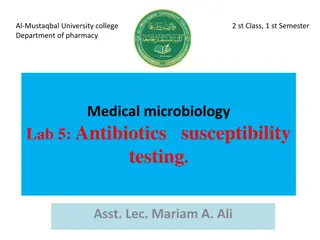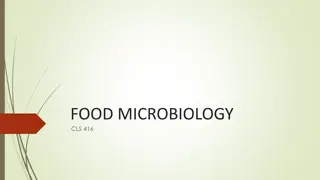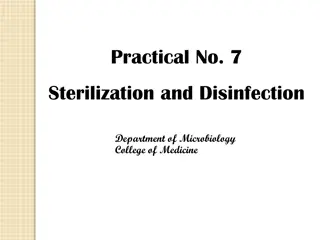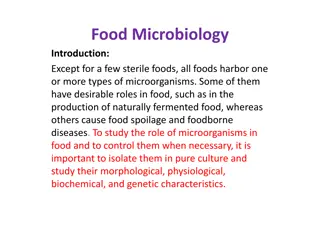Understanding Microbiology: An Introduction to the World of Microorganisms
Microbiology, the study of microorganisms, encompasses the history, branches, classification, and importance of microbes. From prokaryotes to eukaryotes, this field delves into the realm of tiny life forms invisible to the naked eye. Explore the rich history of microbiology, its branches, and the wide scope it encompasses in various scientific endeavors.
Download Presentation

Please find below an Image/Link to download the presentation.
The content on the website is provided AS IS for your information and personal use only. It may not be sold, licensed, or shared on other websites without obtaining consent from the author. Download presentation by click this link. If you encounter any issues during the download, it is possible that the publisher has removed the file from their server.
E N D
Presentation Transcript
UNIT-I INTRODUCTION TO MICROBIOLOGY RASMITA JENA ASSISTANT PROFESSOR SoPLS, CUTM, BBSR
Introduction History of microbiology Branches Scope and its importance Introduction to prokaryotes and eukaryotes Study of ultra-structure and morphological classification of bacteria. Nutritional requirements, raw materials used for culture media Physical parameters for growth, growth curve Isolation and preservation methods for pure cultures Cultivation of anaerobes, quantitative measurement of bacterial growth (total & viable count). Study of different types of phase constrast microscopy, dark field microscopy and electron microscopy.
Introduction Microbiology is the science that deals with the study of microorganisms. The term microbiology derives its name from three Greek words mikros [small] bios [life] and logos [study]. Microorganisms are tiny and invisible to naked eye. So, they can be looked into and studied only with the help of microscope. Small sub-cellular or cellular living beings with milli-micron or micron in size and are not visible to our naked eyes are called micro-organisms.
Micro-organisms are basically classified under the following 2 groups: 1. Prokaryotic microbes: These include subcellular living entities like prions, viroid, viruses and cellular organisms like bacteria, cyanobacteria etc. 2. Eukaryotic microbes: These include cellular microbe belonging to following groups. a. Algae. Ex: Chlamydomonas, Diatoms. b. Fungi. Ex: Yeast, Rhizopus. c. Protozoans. Ex: Plasmodium, Amoeba. Micro-organisms are commonly called microbes and they were the first to occupy planet earth even before man and other creatures. Microbes are present in every part of biosphere.
History of microbiology Although microbes were the first life forms to occupy the planet earth, the knowledge about microbiology is well developed with new dimension only after the invention of microscopes and contribution of knowledge to the field of microbiology from various scientists.
BRANCHES OF MICROBIOLOGY With the accumulation of knowledge about various aspects of microbes since the last century and has spread in to various branches. Thus the various aspects of microbiology study can be divided basically in to following branches. Pure and applied microbiology as well as taxonomy are classified as branches of microbiology
Bacteriology: Microbiology deals with the study of bacteria, which is known as bacteriology. There are also several specializations within this field such as marine bacteriology, agricultural bacteriology, sanitary bacteriology, industrial bacteriology, and systematic bacteriology. In this area of microbiology, we focus on aspects such as types of bacteria and their characteristics, diseases, and applications, etc.
Mycology: The field of mycology deals with eukaryotic organisms such as fungi, as opposed to bacteriology, which studies prokaryotic organisms. Fungi (mold and yeast) can be found in a wide variety of environments and can be beneficial or harmful, depending on the type. In mycology, the focus is on the characteristics and characteristics of these organisms (e.g., their taxonomy, etc.) which have in turn made the use of these organisms possible in a variety of industries such as breweries, food, and medicine. A mycologist is someone who specializes in mycology.
Protozoology: A branch of microbiology based on taxonomy; protozoology is a relatively new branch of the field. The study of protozoa falls under this subfield. This refers to a group of eukaryotic organisms that includes amoeboid, ciliates, sporozoans, and flagellates, as well as fungi. The fact that many of these organisms have been correlated with disease in animals and humans has led protozoologists to examine not only their taxonomy and morphology, but also their medicinal significance. In addition to malaria and sleeping sickness, protozoa can also cause amoebic dysentery
Phycology: A branch of microbiology that deals with multicellular organisms is phycology, like mycology. Phycology, however, deals with the study of algae that occur in a variety of environments as opposed to mycology. While some algae are small microorganisms found in the ocean, others grow into large plants commonly found in the aquatic environment. The production of oxygen makes algae important in microbiology, in addition to being part of the food chain. Phycologists (e.g., Carl Adolph Agardh) study phycology. Parasitology: A parasitologist studies parasites as a branch of microbiology. The principal focus of parasitology is on organisms of three types, namely protozoa, helminths (worms), and arthropods. Parasitology focuses on diseases-causing organisms (e.g., parasites and vectors), and has thus been heavily influenced by other disciplines, such as immunology and biochemistry. In parasitology, unicellular organisms as well as multicellular organisms are studied. Parasitologists are known for their study of parasites.
Immunology: It is the study of the immune system as a sub-discipline of biology. Study of this subject has been important since the 18th Century, when the aim was to boost the body's immunity to prevent illness. While there are many types of diseases caused by various organisms and foreign substances, autoimmunity may also be a cause of disease. By studying the body's relationship with pathogens, scientists have become adept at eradicating diseases that had once plagued society.
Agriculture microbiology - The study of agricultural microbiology encompasses the process of soil nutrient cycling by microbes, the degradation of organic wastes by microbes, and soil fertility enhancement by microbes associated with plants. Industrial microbiology - Industry Microbiology deals with the use of microbes to create antibiotics, enzymes, alcoholic beverages, fermentation products, and other product. Aero microbiology - Aero-microbiology is the study of the microorganisms present in the air, their abundance, and whether they are beneficial or harmful. Food microbiology - There are many microbes that are involved with food spoilage, food borne diseases, and the preparation of commercial foods using microbes.
Exo-microbiology - Life in outer space is the focus of exo- microbiology. Aquatic microbiology - Microbes in aquatic ecosystems purify water and degrade wastes through biological degradation. Medical microbiology - In medical microbiology, we study microbes capable of causing disease, what we can do to diagnose and prevent diseases, and how to design drugs. Geochemical microbiology - Geological Microbiology analyzes microbial life as it occurs in coal formation sites, oil fields, gas fields, and other geochemical settings.
1. Industrial Microbiology It deals with the exploitation of microbes for industrial production. Here the microbes can be considered as mini chemical factories, as they are capable of converting some raw materials into end products which have value for human use. Microbes have been used to produce alcohols, antibiotics and organic acids, in industrial scale. The study of fermentation by microorganisms has provided booster to beverage industry. Recently with great advances in recombinant DNA technologies, provided a better route to manipulate microbes genetically to produce new products.
2. Diary Microbiology It deals with the study of harmful and beneficial bacteria present in milk and milk products. In diary microbiology the aspects like production of (yogurt) fermented milk products. Pasteurization of milk and milk products can be studied. Many such fermented milk products are used in treatment of dysentery and gastro enteritis.
3. Environmental Microbiology It is one of the important branches of microbiology where the role of microbes in maintaining quality of environment is studied. Since microbes are found in every environment the air, water, soil and food, they influence the degradation and decay of natural wastes (bioremediation) they also influence the energy flow in ecosystem. The study also helps to understand freshwater and marine water and their microbes. Recently it has been shown that some genetically modified microbes can help in cleaning oil spills and this gives an added advantage to the study of environmental microbiology.
4. Food Microbiology It is concerned with study of role of microbes in food processing, food preservation and canning. Extensive study of microbes in relation to food products lead to characterization of microbes. As a result new methods have developed and old methods have been improved. This branch also provides a platform for the study of food borne microbial diseases and their control. 5. Agricultural Microbiology In this branch, the role of microbial activity in plants and their surroundings is studied. Many microbes like fungi, bacteria, and viruses cause many diseases in plants. This branch is concerned with study of nitrogen fixation activity. Use of microbes as biofertilizers, use of microbes as bio pesticides and many more aspects.
6. Medical Microbiology The study of pathogenic microbes, the etiology, their life cycle, physiology. Genetics, pathogenicity and control are known as medical microbiology. The integral part of medical microbiology is to understand how immune system of vertebrate protects themselves from pathogens and shows response to the pathogen. This branch primarily allows the study of morphological and cultural characteristic resistance nature of microbes, their diagnosis, treatment and control of infectious diseases. 7. Air Microbiology The branch covers the study of dispersal of pathogenic microbes through air, microbial population in air and control of air borne microbes by chemical agents, radiations, filtration and laminar air flow methods.
6. Medical Microbiology The study of pathogenic microbes, the etiology, their life cycle, physiology. Genetics, pathogenicity and control are known as medical microbiology. The integral part of medical microbiology is to understand how immune system of vertebrate protects themselves from pathogens and shows response to the pathogen. This branch primarily allows the study of morphological and cultural characteristic resistance nature of microbes, their diagnosis, treatment and control of infectious diseases. 7. Air Microbiology The branch covers the study of dispersal of pathogenic microbes through air, microbial population in air and control of air borne microbes by chemical agents, radiations, filtration and laminar air flow methods.
8. Aquatic Microbiology It encompass the study of microbes present in fresh water, ocean water and estuarine. This branch is of great significance that; Many aquatic microbes are pathogenic to human beings: Most of them are important in food chain in the ecosystem. They take part in recycling processes. They help in exploration of oils and minerals. 9. Immunology It is one of the fastest growing areas that covers the practical health problems their nature and treatments. It is the study of immunity against invading microbes by a host.
10. Biotechnology It is the most significant branch that deals with the application of biological techniques for the benefit of mankind. It encompasses the use of microbes for the production of drugs, fermented foods and treatment of waste. It also includes developing techniques for the more efficient production of specific compounds. It focuses on aspects such as nature of genetic material, regulation, development and function of a cell, the method of production of new microbial cells by recombinant DNA technology which are useful in industrial microbiology. 11. Exo-Microbiology It is branch still in its infancy, it includes explore and the study of microbes in outer space and other planets such as moon and mars.
12. Geo-chemical Microbiology Study of role of microbes in coal, gas and mineral formation. Exploration of oil, gas and minerals is known as geochemical microbiology. In addition to the above mentioned branches, the basic microbiology encompasses the following branches that are concerned with the study of morphology, ecology, taxonomy, genetics and physiology of specific groups of microbes. 1. Bacteriology-Study of bacteria 2. Phycology- Study of algae 3. Mycology -Study of fungi, [molds and yeasts]. 4. Virology- Study of viruses 5. Protozoology- Study of protozoa
Scope of Microbiology With the development of new laboratory techniques and experimental procedures our knowledge on characteristics on microbes accumulated rapidly. Research on microbes gave booster for the recent developments in the genetic engineering and biotechnology scientists from many disciplines recognized the usefulness of microbes as experimental models Thus microbiology played a crucial role in the development of biotechnology. Microbes like E.coli facilitated in biotechnology.
The gene cloning in the industrial production of some therapeutics such as insulin, interleukin, calcitonin etc. The molecular scissors (Restriction endonucleases) that used in genetic engineering are isolated from the microbial sources. The plasmids (small circular extra chromosomal self-replicating DNA) derived from microbes are used as vectors for transferring genes form one organism to another. Ex: PUC18, PBR322, etc. The bacterium like Agrobacterium tumefaciens can be employed to generate transgenic plants. This bacterium bears Ti (Tumour inducing) plasmids that can be used to transfer the desired genes in to host plant.
Importance and Scope of Microbiology Microbiology is an applied science that has great impact on genetics, biochemistry, food sciences, ecology, immunology, agriculture, medicine and many other disciplines. Despite their small size they form the largest resource for biotechnology. Various microbial genera have been used to study their genetics and molecular biology. "Escherichia Coli" is a wonderful colon bacterium that has been extensively studied by biotechnologists. They used it for cloning and Microbes play a pivotal role in human welfare majority of the microbes are useful to mankind but some of them are harmful as they cause infectious diseases in human beings, domestic animals and agricultural crops.
1. Biotechnology: a. Microbes produce very important DNA manipulating enzymes like REN (Restriction Endo Nucleases) and Ligase. These two are used as molecular scissors and stitches in biotechnology/ Genetic Engineering. b. Some microbes, for example: E.coli is used as host organism to clone desired gene for desired product.
2. Agriculture: from the point of agriculture microbes play an important role in the following aspects. a. Some microbes can be used as bio-fertilizers to enrich soil fertility. b. Some bacteria can fix inert atmospheric nitrogen known as nitrogen fixing bacteria. Ex: rhizobium, Azotobacter, Anabaena etc. c. Some microbes like viruses and bacteria are used as bio- pesticides to protect the crop plants from pest and insect eating.
3. Industry: from the point of industry, microbes are extremely useful a. for the production of industrial chemicals like acetic acid, lactic acid, citric acid etc. by fermentation process. b. Microbes also find their importance in food industry and dairy industries to produce fermented food products. c. Microbes also play an important role in the production of ethyl alcohol in brewing industry. d. Microbes also find their importance in food and dairy industry to produce fermented food products.
4. Medicine: a. From the point of medicine various kinds of antibiotics used to treat pathogenic diseases of man and animals are derived from microbial group called actinomycetes. b. Some heat killed microbes are used as vaccine against various kinds of pathogenic microbes causing diseases. 5. Environment: a. Microbes help to clean the environment by degrading all kinds of biodegradable waste products. Hence, the microbes are regarded as scavengers of nature. b. Microbes play important role bio-geo chemical cycles. c. Microbes also play an important role in the production of Bio-gas from the biological waste products.
6. Bio-remediation: It is a method of pollution alleviation using microbes. Several bacteria and fungi are capable of decay the natural waste, toxic chemicals, heavy metals, oil spills etc. 7. Bioleaching: When the ore contains lower metal content, it is difficult to extract them by direct smelting, in such cases some microbes (Thiobacillus species) are used to separate the mineral from crude ores. This process is known as bioleaching or microbial leaching.
Introduction to prokaryotes and eukaryotes The cell was first seen by Robert Hooke in 1665 using a primitive, compound microscope. He observed very thin slices of cork and saw a multitude of tiny structures that he resembled to walled compartments of a monk. Hence, named them cells. Hooke's description of these cells was published in Micrographia. The cell is smallest unit of a living system and fall in the microscopic range of 1 to 100 m. They attain various shapes and sizes to attain variety of functions. One of most important characteristics of cell is ability to divide. A cell has evolved from an already existing cell and further it can give rise to a new cell. This was first stated by Theodor Schwann.




